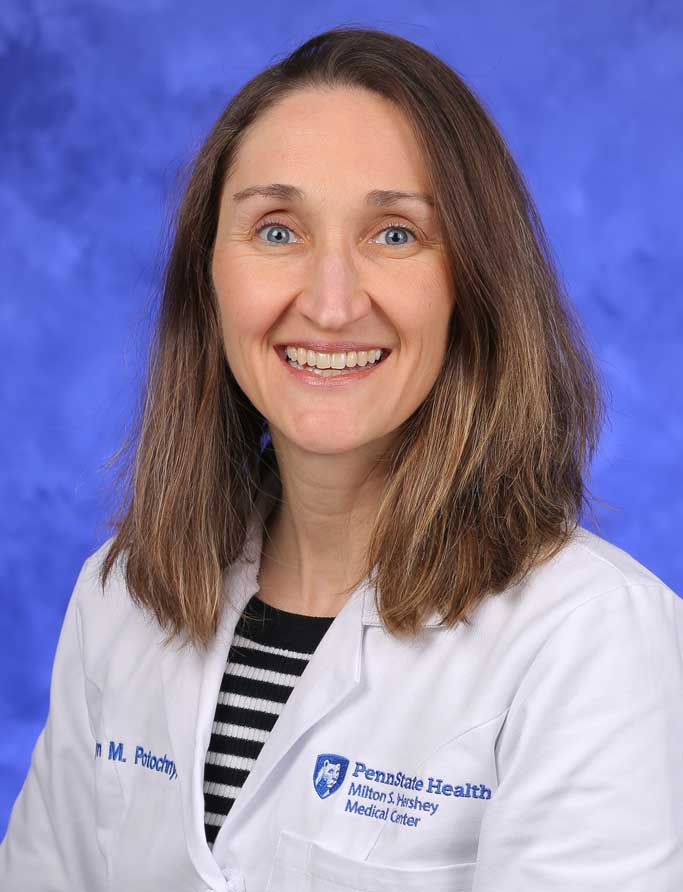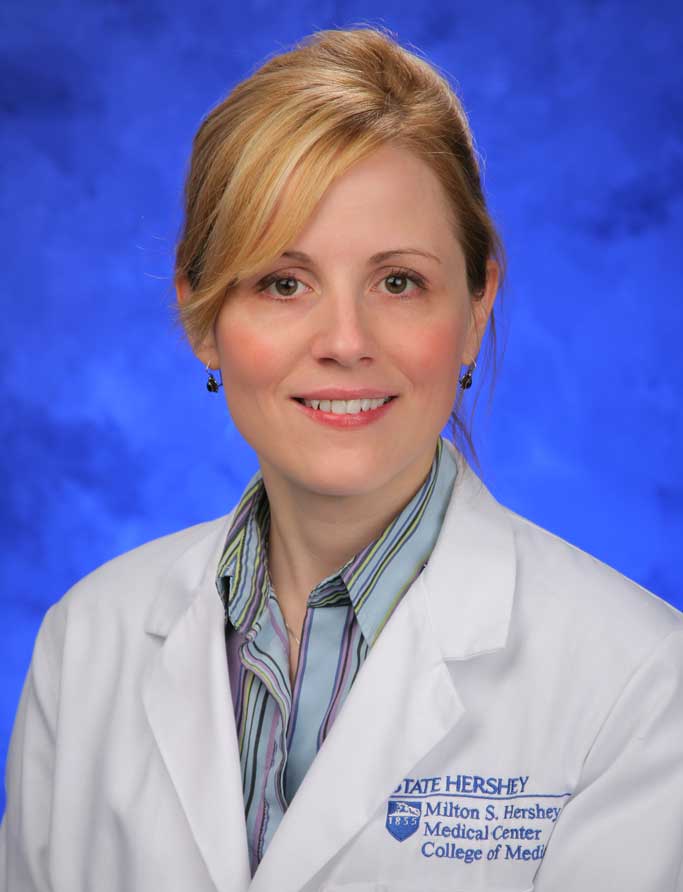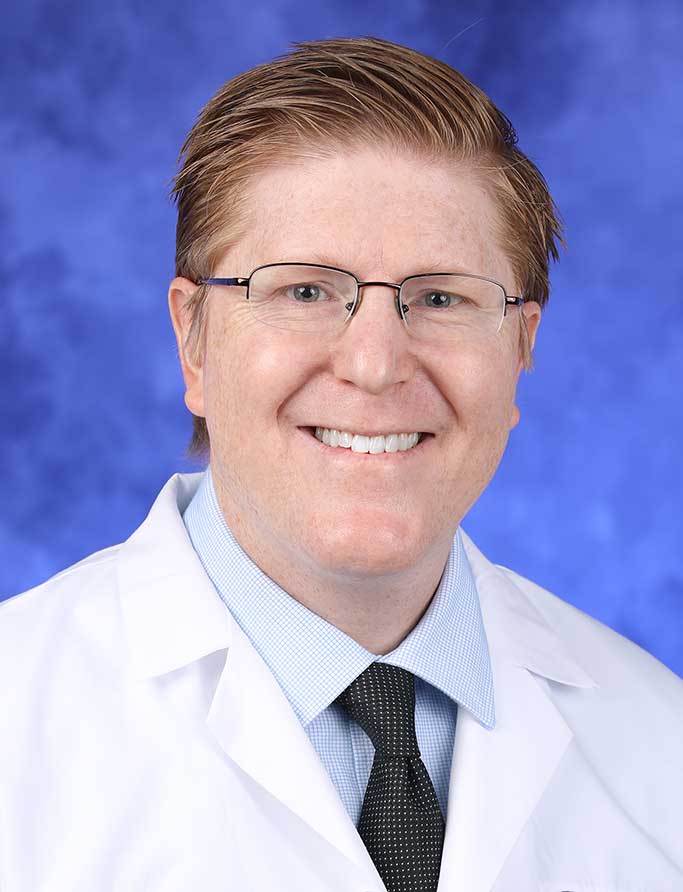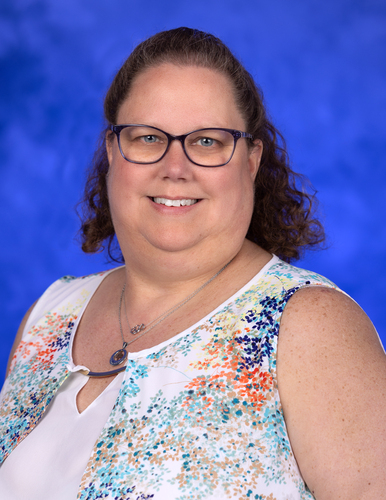Jump to topic
Search
Program Details
Penn State Health Milton S. Hershey Medical Center and Penn State College of Medicine offer pathology residency training in combined anatomic and clinical pathology, anatomic pathology alone or clinical pathology alone.
The Pathology Residency is an integral part of the Department of Pathology and plays an important role in the academic and clinical life of the medical center.
During their training at Penn State Health Milton S. Hershey Medical Center and Penn State College of Medicine, residents build their knowledge and experience in the various disciplines of anatomic pathology, clinical pathology and experimental pathology. Faculty members are strongly committed to the education of residents. They serve as instructors and mentors across the broad range of experiential and didactic educational activities offered by the department.
Learning on rotations is supplemented by a core curriculum of didactic lectures spanning all sub-specialties of anatomic and clinical pathology, as well as presentations on important topics by nationally well-known visiting professors. A rich and diverse array of departmental and interdisciplinary conferences allows residents to refine their diagnostic skills, gain exposure to rare and unusual cases, and contribute to patient evaluation and management. In addition, a Visiting Professors lecture series features nationally acclaimed faculty covering important concepts in pathology education, research and practice.
Residents benefit not only from clinical pathology and anatomic pathology topics discussed and unknown slide reviews shared or lab management case studies, but meeting and networking with leaders in the field of pathology.
As resident pathologists, trainees have the opportunity to be clinical specialists as well as basic scientists. The skills and knowledge acquired during residency prepare trainees to function as an expert in providing diagnostic and prognostic information. The discipline of pathology is a link to other basic medical sciences. For those interested in pursuing biomedical research, there are opportunities to train with members of the Division of Experimental Pathology, as well as with other faculty members involved in basic or clinical research. This residency program is designed to prepare trainees for the ever-changing world of laboratory medicine. Educational opportunities in cytogenetics, molecular diagnostics and laboratory management are all part of the residency experience.
A mentoring program allows each resident the opportunity to select a faculty member for one-on-one career guidance and professional development. Many faculty were attracted to the field of pathology by the broad range of opportunities including clinical practice, medical education, research and laboratory administration. Program faculty are trained and experienced in these diverse sub-specialties, and stand ready to help residents meet their goals.
The laboratory facilities at Penn State Health Milton S. Hershey Medical Center are exceptional. The modern full-service laboratories are well-equipped and designed to meet the needs of a tertiary-care facility. Departmental and institutional libraries include a large selection of electronic journals and print journals and books. Resident offices provide an opportunity for sharing knowledge in a comfortable, private area with adequate space for each individual.
In summary, this environment for pathology training is outstanding and one that will prepare trainees well for the opportunities that their futures will offer them.
Learn More about the Residency
General
- Faculty-resident mentoring program since 1998
- Mentored quality improvement projects
- Faculty and resident wellness committee
- Resident research curriculum, with opportunity for involvement in basic and/or multidisciplinary translational research, support of Pathology Core Research Laboratory and funding available through the department and institution
- Residents-as-educators curriculum (including opportunities to give lectures, attend conferences and attend visiting professor and distinguished educator lectures)
- Opportunity to participate in medical student education (e.g., pathology electives, laboratory and problem-based learning/team-based learning sessions)
- Opportunity to receive certification in Stanford Clinical Teaching (through the Woodward Center for Excellence in Health Sciences Education) and participate in Basic Training by the Institute of Healthcare Improvement, as well as Lab Management University through ASCP
- Two-year longitudinal core curriculum (two-year cycle of didactic lectures given by anatomic and clinical pathology, including laboratory management topics
- Subscriptions to online educational modules/practice exams: Medical Training Solutions, Media Lab CE, Resident In Service Exam (RISE Plus, includes question bank) and board vitals review question banks
- Residents actively encouraged and supported in departmental and institution-level and national committee membership
- Faculty with expertise and board certification in a full spectrum of specialty areas
- Faculty dedicated to teaching, many of whom have education roles at the institutional level
- Active participation in decision-making concerning residency program
- Opportunity for an outside elective rotation
- 100 percent pass rate on Anatomic Pathology/Clinical Pathology boards since 2010
- ACGME-accredited fellowships in dermatopathology, hematopathology, blood banking/transfusion medicine and surgical pathology
- Successful placement of residents in fellowships of their choice at Penn State Health Milton S. Hershey Medical Center and other prestigious institutions
Anatomic Pathology
- Graduated autonomy with opportunity for semi-independent signout as senior resident
- Supervised experience presenting in interdisciplinary conferences and tumor boards
- Serve as primary pathologist for one interdisciplinary conference as senior resident
- High-volume experience with clinical specimens across all specialties, including approximately 40,000 surgical pathology specimens, 20,000 cytology (10,000 Paps, 5,000 fluids and 5,000 FNAs) and 90 autopsies per year
Clinical Pathology
- Hands-on clinical pathology training with focus on methodology and clinical consulting to various medical services
- Direct patient care responsibilities on transfusion medicine service
- Opportunity to receive a Certificate of Apheresis Competence
- Clinical pathology attendings rotate service coverage almost daily, allowing varied exposure to these attendings
- Clinical pathology consult rotations allowing real-time resolution, discussion and learning about all aspects of laboratory medicine and its management
- Participation in CAP laboratory inspections (internal and/or external)
- Interactions with postdoctoral fellows in medical microbiology and clinical chemistry
Application and supporting materials for the Pathology Residency must be submitted via ERAS (Electronic Residency Application Service). Applications sent directly by regular or electronic mail will not be accepted or considered.
Required items that should be sent to ERAS include:
- Copy of a dean’s letter
- Transcript
- Official USMLE/COMLEX Step 1 scores
- Three letters of recommendation
USMLE/COMLEX Step 2 must be taken, passed and scores received by February of the program entrance year. Step 3 scores are not necessary, but are helpful.
International medical graduates are also required to have ECFMG certification and have a currently valid ECFMG certificate to present upon employment. Only J-1 visas are sponsored.
The candidate’s entire application package is evaluated during the review process. There are no defined minimum USMLE/COMLEX scores, grade-point averages or year of graduation from medical school; however, it is important that an applicant shows evidence of continual learning during any period of absence from the field of pathology and medicine. Work experience in a U.S. clinical laboratory is not required. Observerships are not allowed in any department within Penn State Health Milton S. Hershey Medical Center.
Application Timetable
ERAS deadline is Dec. 1 of the year before desired program start date. Interviews are generally conducted on a rolling basis between October and January, and selected applicants will be contacted by email to set up interview dates. Match Day takes place in March.
Research Opportunities
The Department of Pathology is committed to research, and encourages residents to participate in research projects. Applications from physician-scientists are welcomed. The department will work with candidates interested in combining clinical and research training to plan a program that both meets the requirements of the American Board of Pathology and integrates structured research training, which may include up to six months of research time during residency. A select group of applicants may qualify for a guaranteed additional year of support to pursue their research interests.
Candidates interested in these opportunities are encouraged to contact Program Director Evelyn Potochny, DO, at epotochny@pennstatehealth.psu.edu, in addition to submitting the ERAS application.
Virtual Tour
Penn State Health
Penn State Health is a multi-hospital health system serving patients and communities across 29 counties of Pennsylvania. Its mission is to improve health through patient care, research, education and community outreach.
In December 2017, the system partnered with Highmark Health to facilitate creation of a value-based, community care network in the region. The shared goal of Highmark and Penn State Health is to ensure patients in the community are within:
- 10 minutes of a Penn State Health primary care provider
- 20 minutes of Penn State Health specialty care
- 30 minutes of a Penn State Health acute care facility
Learn more about Penn State Health
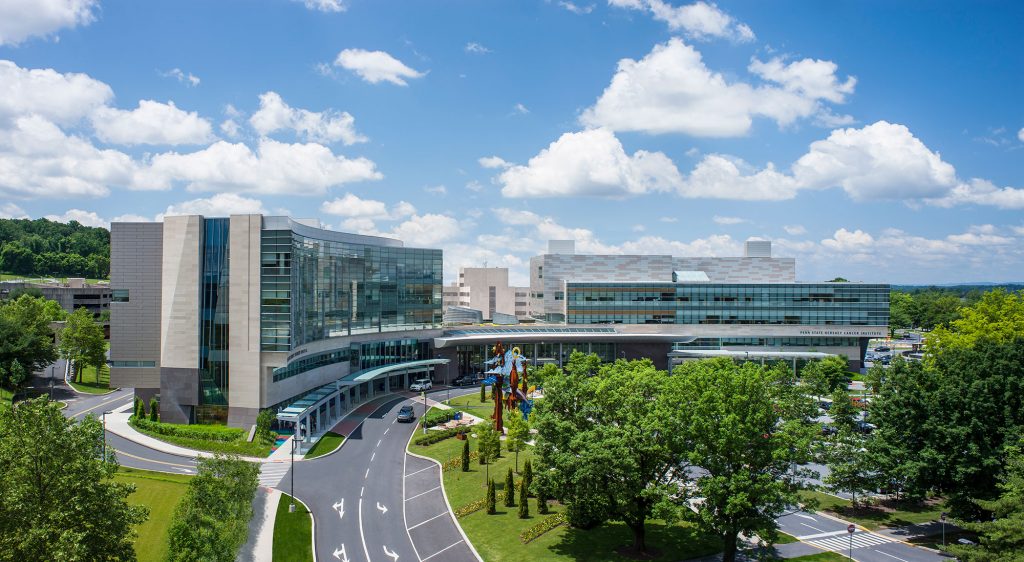
Penn State Health Children’s Hospital (left), Penn State Health Milton S. Hershey Medical Center (center) and Penn State Cancer Institute (right)
Penn State Health Milton S. Hershey Medical Center
500 University Dr., Hershey, Pa., 17033 (Derry Township, Dauphin County)
- The health system’s 647-bed flagship teaching and research hospital
- The only medical facility in Pennsylvania accredited as both an adult and a pediatric Level I (highest-level) trauma center
- Dedicated surgical, neuroscience, cardiovascular, trauma and medical intensive care units
- Accredited Life Lion critical-care transport providing more than 1,100 helicopter and approximately 750 ground ambulance transports per year
- More than 1,300 faculty members and more than 650 residents and fellows
- Approximately 29,000 admissions, 73,000 emergency department visits, 1.1 million outpatient visits and 33,000 surgical procedures annually
- Designated as a Magnet hospital since 2007
Learn more about Milton S. Hershey Medical Center
Penn State Health Children’s Hospital
600 University Dr., Hershey, Pa. 17033 (Derry Township, Dauphin County)
- An eight-story, 263,000-square-foot-facility built in 2013 and expanded in 2020
- 160 licensed pediatric beds, 26-bed pediatric intensive care unit and a 56-bed neonatal intensive care unit
- Level IV (highest-level) neonatal intensive care unit
- Level I quaternary (highest-level) pediatric intensive care unit
- Level I (highest-level) pediatric trauma center designation
- Intermediate care unit
- Dedicated pediatric operating rooms
- More than 150,000 pediatric outpatient visits, 20,000 pediatric emergency room visits, and approximately 5,000 pediatric patient discharges annually
Welcome to Hershey
More About Hershey
Interested in learning more about living and working in Hershey, Pa.? See details here:
Wellness, including emotional, spiritual, social and physical health, is a crucial component to training and to becoming a professional, compassionate and resilient physician. Self-care is a skill which must be continually practiced and reinforced. Penn State College of Medicine and Penn State Health are committed to addressing wellness among residents and fellows, with multiple resources readily available.
Institutional resources
- Visit BeWell – a health program designed to support Penn State Health employees
- See Penn State College of Medicine wellness resources here
- Employee Health Care Concierge and Case Management Service
- Partners in Medicine
Moving to a new city with your family does not have to be stressful. Residency programs have assisted many significant others with finding employment. There is also a GME-Wide Partners in Medicine (PIM) group that offers networking opportunities as well as various social and community oriented activities. - The Doctors Kienle Center for Humanistic Medicine
- Active and easily accessed Office of Professional Mental Health
Graduate medical education resources
Institutional Resources
Penn State Health and Penn State College of Medicine celebrate, embrace and support the diversity of all patients, faculty, staff, students and trainees.
Office for Diversity, Equity and Inclusion
In keeping with this, Penn State Health has an active Office for Diversity, Equity and Inclusion with various programs, networks and resource groups, including:
- Talks and lectures on diversity, equity and inclusion through the Inclusion Academy
- Regular events on topics such as eradicating racism and creating a culture of inclusiveness
- Many Business Employee Resource Groups (BERGs), including:
- Disability Business Employee Resource Group
- Interfaith Business Employee Resource Group
- LGBTQ+ Business Employee Resource Group
- Military and Veterans Business Employee Resource Group
- Multicultural Business Employee Resource Group
- NextGen Business Employee Resource Group
- Black Physician Professional Staff Association – Resource Group
- Hispanic Professional Association
- Asian Physician and Professional Staff Association
- International Workforce Inclusion
Learn more about the Penn State Health Office for Diversity, Equity and Inclusion
Learn more about the College of Medicine’s Office for Diversity, Equity and Belonging
Office for Culturally Responsive Health Care Education
The vision at Penn State College of Medicine and Penn State Health is to equip learners with the knowledge, skills and attitudes they will need to provide culturally excellent health care and research for an increasingly diverse U.S. population. The Office for Culturally Responsive Health Care Education was formed to help meet that goal.
Learn more about the Office for Culturally Responsive Health Care Education
Office for a Respectful Learning Environment
In addition, the institution does not tolerate discrimination, biases, microaggression, harassment or learner mistreatment of any kind, and any concerns are immediately addressed by the Office for a Respectful Learning Environment.
Learn more about the Office for a Respectful Learning Environment
Network of Under-represented Residents and Fellows
The Network of Under-represented Residents and Fellows (NURF) is a group of diverse residents and fellows representing all specialties. NURF’s goal is to promote cultural diversity in the residency programs through community involvement, mentorship with diverse faculty, professional networking and support for the recruitment of diverse medical students into the residency programs.
NURF is sponsored by the Penn State College of Medicine Graduate Medical Education Office and the Penn State Health Office for Diversity, Equity and Inclusion.
Mailing Address
Penn State Health Milton S. Hershey Medical Center
Penn State College of Medicine
Department of Pathology
MC H083
500 University Dr.
Hershey, PA 17033
General Contact Information
Email: PathologyResidencyProgram@pennstatehealth.psu.edu
Phone: 717-531-8247
Pathology Divisions
The Division of Anatomic Pathology is composed of more than 20 faculty members, including those at Penn State Health Milton S. Hershey Medical Center and those at affiliated community hospitals. All share a firm commitment to pathology resident education.
The pathology resident’s education is based on a strong foundation of clinical material seen at Hershey Medical Center and Penn State Children’s Hospital. An expanding health system promises additional volume of clinical material in the near future.
The case material includes approximately 42,000 surgical specimens, 15,000 cytology specimens and 90 autopsies.
Since Hershey Medical Center is a tertiary-care center with a broad geographic catchment area, the pathology department receives more than enough specimen volume, of sufficient depth and breadth, for the trainee to develop competence and confidence as a diagnostician. Challenging diagnostic specimens reflect the patients treated here, including complex resections of advanced solid neoplasms, hematologic malignancies, bone and soft tissue tumors, neuropathology, transplant pathology, iatrogenic immunosuppression, unusual infections and pediatric diseases.
The annual rotation schedule is organized into 13 four-week blocks. The core anatomic pathology rotations include 16 blocks of subspecialty surgical pathology. Low-volume autopsy rotations are combined with other rotations to maximize experience: six blocks of autopsy/cytopathology, one block of autopsy/gross dissection and one block of autopsy/pediatric pathology. One block of forensic pathology experience is provided at the coroner’s or medical examiner’s office in Dauphin or Lancaster counties respectively.
Ancillary techniques such as electron microscopy, molecular diagnostics, flow cytometry, immunofluorescence and immunohistochemistry are incorporated into these basic rotations as well as in elective rotations.
During the training period, one “away” elective (two- to four-week block) can be arranged at an outside institution with approval from the Designated Institutional Official. Selective rotations allow additional diagnostic patient care experience with gross dissection optional.
Five blocks of elective rotations are available to be taken in anatomic and/or clinical pathology. Electives may be used for additional diagnostic rotations, enrichment in low-volume specialties or research.
As residents gain experience, they are encouraged to take on more responsibility in patient care and teaching roles. Semi-independent sign-out in surgical pathology is an extremely valuable privilege awarded to qualifying senior residents, which allows them to approximate the experience and autonomy of a junior faculty member.
Residents are expected to participate in research, and opportunities abound with abundant case material and enthusiastic faculty mentors. Research initiation grants support presentation at national meetings. Project outcomes are presented internally at the Research and Quality Grand Rounds.
Hershey Medical Center’s cytopathology laboratory has a total annual volume of approximately 15,000 cases. Approximately 50 percent of these are Pap tests, 30 percent are fluid cytologies and 20 percent are fine-needle aspiration specimens.
Cytopathologists attend most radiographically-guided FNAs to provide immediate feedback on adequacy and a preliminary diagnosis when appropriate. Cytopathologists perform fine-needle biopsies on a variety of superficial lesions. A typical four-week cytopathology rotation will include exposure to more than 100 FNAs from lungs, lymph nodes, thyroid, abdominal organs, bone and other sites. A formal curriculum of reading assignments, study sets, lectures, technical skills, and post-tests exists, organized into three two-month blocks (gynecology, fluids, FNA), with a checklist to help the resident assure that all goals have been met.
Each week, the teaching calendar for the section includes an anatomic pathology “unknowns” conference, dermatopathology conferences and a gross pathology conference. Clinicopathologic correlation, the generation of a complete differential diagnosis, pathogenesis, natural history and response to therapy are stressed. Interdisciplinary subspecialty tumor boards and medical conferences that correlate pathologic observations with radiologic and clinical data, and core curriculum lectures covering the full range of anatomic pathology subspecialties, complete the weekly calendar.
Residents will have the opportunity to serve as the presenting pathologist at interdisciplinary conferences throughout training, where they will provide information important for influencing patient-care decisions. Senior residents select an interdisciplinary conference for which they are the primary pathologist for the entire year.
Residents will be invited to serve as instructors in medical student laboratories, facilitate problem-based learning sessions, provide formal lectures in the core curriculum and present their Quality Improvement projects at the annual Research and Quality Grand Rounds. Education skills are nurtured through the institutional Residents as Educators program.
Residents on autopsy rotations perform autopsies under the guidance of an attending pathologist. Opportunities exist for senior residents to spend one or two months supervising junior residents. In addition to extensive reading, an integral part of each resident’s training is participation in several types of conferences, each emphasizing different aspects of autopsy pathology (e.g., autopsy case review conference, gross organ conference, medical mortality conference, neuropathology and perinatal pathology conferences). Teaching second-year medical students is an important and valuable part of the rotation. Residents also observe and participate in forensic cases performed at the local coroner’s office. There also exists an opportunity to experience other facets of forensic pathology (e.g., scene investigation and legal testimony) during the four-week block rotation with the local medical examiner.
Education in anatomic pathology laboratory management is incorporated in the core curriculum, as an experiential learning opportunity in quality improvement, through inclusion of residents in divisional quality assurance meetings, through participation in capital budget and departmental budget planning, and by involving residents in the preparation for, and sometimes service as an inspector in, College of American Pathologists laboratory inspections.
The Division of Clinical Pathology is composed of 10 faculty members who provide medical and scientific direction for the hospital’s clinical laboratories and specific core and research laboratories. The clinical laboratory performs more than 4.5 million billed tests each year, reflecting the diverse population of patients seen at this academic medical center.
The laboratory includes units for transfusion medicine/apheresis, hematopoietic stem cell processing, molecular diagnostics, flow cytometry, coagulation laboratory, microbiology/parasitology, virology, automated hematology and hematopathology, chemistry, HLA/immunology, laboratory information systems, phlebotomy/specimen collection and specimen processing, as well as a Core Reference Laboratory for toxicology and translational and basic research support.
As residents rotate through the various laboratory units, they receive instruction from the faculty and medical laboratory scientists in each section.
The Pathology Residency’s annual rotation schedule contains 13 four-week blocks. In the course of their training in clinical pathology, residents become familiar with the technical aspects and clinical applications of each laboratory procedure through active participation in bench work and frequent consultations with clinicians. The core clinical pathology rotations include four blocks of blood bank/apheresis, three blocks of microbiology, one block of virology, five blocks of hematology (two blocks of clinical pathology focusing on peripheral smear review, cell counting and coagulation; two blocks of anatomic pathology focusing on lymph node and bone marrow slide review, flow cytometry and molecular testing; and one block in the final year combining both clinical hematology and anatomic hematopathology service work), three blocks of chemistry, two weeks of HLA/immunology followed by two weeks of blood bank bench and two weeks of cytogenetics training combined with an elective.
There are also three blocks of clinical pathology consult rotations, in which the resident acts as the front-line laboratory director. Residents on clinical pathology consult are exposed to laboratory management, specialized testing, molecular diagnostics training and the role of the pathologist as a consultant to clinicians regarding laboratory test utilization and interpretation.
Residents rotate through each unit and serve as laboratory physicians in all unit activities. During their rotations, residents are members of the unit management team and are actively involved in administration, planning and implementation of services, as well as solving operational problems. In addition, residents participate on numerous hospital committees and are encouraged to attend and provide continuing education conferences. Opportunities to participate in research projects are available for those interested.
There are five blocks of elective rotations. Residents can arrange electives in areas of anatomic or clinical pathology. During the training period, one “away” elective (two- to four-week block) can be arranged at an outside institution in an area of special interest. The away elective must be approved by the Designated Institutional Official.
The Division of Experimental Pathology is dedicated to improving human health through basic and translational research that involves the study of disease or disease processes. This is a growing group, currently of seven faculty with PhD or MD/PhD degrees, occupying about 10,000 square feet of laboratory space. Four faculty members also fall under the umbrella of The Jake Gittlen Laboratories for Cancer Research, which is supported by a local charity. Areas of research include a range of topics, from molecular and genetic studies of esophageal, bladder and skin cancer, to the biochemical basis of mutation, genetic mechanisms of papillomavirus-induced cancer, polycystic ovary disease, zebrafish as a model for personalized medicine, the genetic basis of skin color, web-based infrastructures for science and high-dimensional image informatics.
Division faculty collaborate with their colleagues in anatomic and clinical pathology and with other basic and clinical scientists. These faculty participate in residency training by offering research opportunities and by contributing to curriculum and research conferences. Faculty also participate locally in medical and graduate education at Penn State and globally through collaborative research and scholarly activity.
Curriculum Details
Pathologists’ activities encompass several broad categories:
- Providing direct patient care by contributing to diagnostic and prognostic evaluation of a variety of samples.
- Medical and scientific direction of clinical laboratories with responsibility for providing high quality laboratory data in a cost-effective and timely fashion.
- Teaching students, residents, physicians, and paramedical personnel about pathologic evaluation of disease and the applications of laboratory medicine to patient care.
- Developing new knowledge about the pathogenesis of disease and its classification and prognostic evaluation.
A career in pathology can be dedicated to one or more of these focuses, in an academic, private practice or commercial laboratory setting. The objective of this residency in pathology is to provide opportunities for each resident to gain personal, participatory experience in the various skills needed to achieve success in their professional careers.
To that end, the program is designed to provide the following:
- A setting that is conducive to self-study and learning-by-doing.
- Training and personal experience in a variety of skills necessary to obtain diagnostic and prognostic information from patient samples.
- Guidance in developing the skills of critical and analytic thinking necessary for proper interpretation of patient or research data.
- Guidance in perfecting the skills of communicating information about disease, both oral and written.
To achieve these objectives, the resident and attending staff must work together with mutually understood expectations and commitments. In general, the resident is expected to do the following:
- Enthusiastically perform the assigned clinical services.
- Read extensively about the diseases encountered.
- Acquire understanding and experience with the technical and mechanical aspects of the laboratory.
- Develop the skills required to communicate information about pathology.
- Gain experience in the skills required for problem solving and for interpretation of data.
- Gain experience in laboratory management and quality improvement.
- Assume a role in the education of colleagues.
Likewise, members of the faculty of the Department of Pathology are expected to do the following:
- Help each resident define career and educational objectives.
- Evaluate each resident’s progress, using subjective and objective means of evaluation, and communicate the results of those evaluations to each resident on a timely basis.
- Delegate to each resident gradually increasing levels of responsibility, based on the resident’s experience and progress in the training program.
- Communicate to residents their enthusiasm for their own area of research and provide opportunity for participation by interested residents.
- Provide personal instruction to residents as appropriate for their subspecialty focus.
- Participate on a regular basis in conferences that are intended primarily for the education of pathology residents.
- Provide personal instruction in laboratory management and administration, and in use of computers in the laboratory.
- Nurture an atmosphere of mutual respect and trust.
- Encourage the development of residents’ participation in scholarly activities.
- Encourage and provide opportunities for residents to gain competency, proficiency and to reach a level in which they are ready to enter independent practice.
The particular requirements for pathologists in practice will continue to change, so the content of the training program must keep pace with trends in the profession. In light of this, the department engages in an annual review of the residency program with a goal of optimizing the educational programming and resources. This review includes a discussion of recent national trends and consideration of future directions of growth for the program.
Recent initiatives include expansion of the elective offerings to include a private practice elective in anatomic pathology and an orthopedic pathology elective. A new clinical pathology consult rotation and a rotation in coagulation have been added. Cytogenetics training has been expanded. These changes are designed to help make residents more competitive in their search for the ideal fellowship or job at the completion of their residency.
A number of conferences are available to Pathology faculty and residents.
Daily Anatomic Pathology sign-out begins at 8 a.m. depending on subspecialty service.
Daily Clinical Pathology sign-out begins at 11 a.m.
Mondays
- 8 to 9 a.m., first and third: Gyn Onc Tumor Board
- MANDATORY: Noon to 1 p.m., weekly: Resident Core Curriculum Conference
- 4 to 5 p.m., second: Pediatric GI Conference
- 5 to 6 p.m., second: Adult Sarcoma Conference
Tuesdays
- 7 to 8 a.m., first and third: Musculoskeletal Conference
- 7:15 to 8:15 a.m., first and third: Neuromuscular Pathology Conference
- 8 to 9 a.m., first: Neuromuscular Slide Review Staff Conference
- 8 to 9 a.m., six times a year: Visiting Professor Lecture, including slide review with residents and noon or educational session; lunch provided
- 8 to 9 a.m., third: Blood Bank Journal Club
- Mandatory: Noon to 1 p.m., weekly: Surgical Pathology Conference, for all residents except those doing clinical pathology only
- Mandatory for residents on clinical pathology rotations: 2 to 3 p.m., fourth: CP Interesting Case Conference
- 4 to 5 p.m., second: GI Tumor Board
- 4 to 5 p.m., third: Renal Biopsy Conference
- 5 to 6 p.m., last: Melanoma and Skin Tumor Board
Wednesdays
- 7 to 8 a.m., first: Ophthalmology Pathology Conference
- 8 to 9 a.m. weekly: Dermatopathology Conference
- 11:30 a.m. to noon, first and third: Liver Transplant Conference
- Mandatory: Noon to 1 p.m.: Resident Core Curriculum Conference
- Noon to 1 p.m., four times a year: Journal Club
- Noon to 1 p.m., third: Autopsy conference, for all residents except those doing clinical pathology only
- 2 to 3 p.m., first: Thyroid Conference
- 3 to 4 p.m., third: Clinical Pathology Quality Improvement Meeting
- 4 to 5 p.m., fourth: GI Fellows Conference
- 4 to 5 p.m., first, third and fourth: Head and Neck (ENT) Tumor Board
- 4 to 5 p.m., third (quarterly): Anatomic Pathology Quality Assurance Meeting
- 5 to 6 p.m.: Hematologic Malignancy Conference
Thursdays
- 7 to 8 a.m., second and fourth: GU Tumor Board
- 7:30 to 8:30 a.m., first: Pediatric Neuro-Oncology Conference
- 7:45 to 8:45 a.m., weekly: Hematology/Oncology Grand Rounds
- 8 to 9 a.m., first (September to May): Dermatology Grand Rounds, auditorium or lecture room
- 11 a.m. to noon, weekly: Breast Tumor Conference
- Mandatory for residents on anatomic pathology rotations: Noon to 1 p.m., first third and fifth: Gross Pathology
- Noon to 1 p.m., second and fourth: Hematopathology Didactic
- Noon to 1 p.m., second: Frozen Section
- Mandatory: Noon to 1 p.m., fourth: Research and Quality Conference
- Mandatory for residents on clinical pathology rotations: Noon to 1 p.m., first and third: Benign Hematology
- 1 to 2 p.m., third: Dermatology Patient Conference
- 2 to 3 p.m., first: Pediatric L/L Conference
Fridays
- 7 to 8 a.m., last: GI Tumor Board
- 7 to 8 a.m., first, third and fifth: Neurosurgery Tumor Board
- 7:30 to 8:30 a.m., second: Pulmonary Conference
- 11 a.m. to noon, second and fourth: Gynecology Tumor Board
- 11 a.m. to noon, first and third: NP Conference
- Mandatory: Noon to 1 p.m., weekly: Core Curriculum Conference
- Noon to 1 p.m., second and fourth: Renal Transplant Conference
- Noon to 1 p.m., first: Resident lunch with department and program leadership
- Noon to 1 p.m., fourth: Pathology Residency Program Review Committee
- 1 to 2 p.m., first and third: Pediatric Tumor Board
Resident Honors and Recognitions
Chief residents and co-chief residents of the Pathology Residency are listed here.
Penn State College of Medicine and Penn State Health Milton S. Hershey Medical Center accept ongoing nominations for the Exceptional Moments in Teaching award.
The award, given monthly by the Office for a Respectful Learning Environment, accepts nominations from College of Medicine students who are invited to submit narratives about faculty members, residents, fellows, nurses or any other educators who challenge them and provide an exceptional learning experience. See more about the award here.
Previous nominees from the Pathology Residency are listed here. Click the + next to a nominee name to read their nominator’s comments.
The annual Resident/Fellow Research Day is held each year (with exception of during the COVID-19 pandemic) on and around the Penn State Health Milton S. Hershey Medical Center campus.
The intent of the event is to provide an opportunity for residents and fellows to showcase their research accomplishments to their peers in other clinical departments, as well as their colleagues in the basic sciences.
Learn more about Resident/Fellow Research Day here.
Previous presentations from the Pathology Residency are listed here.
A selection of recent peer-reviewed publications with Pathology Residency trainees as authors appears here.
Latest News from Pathology




